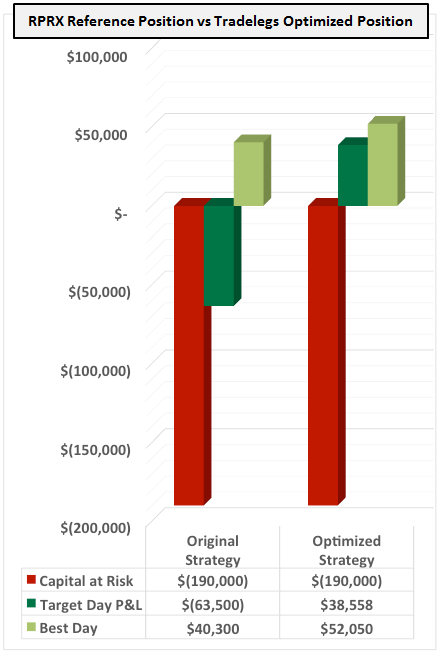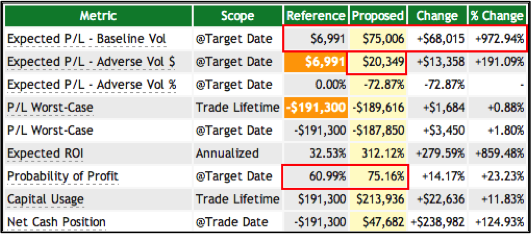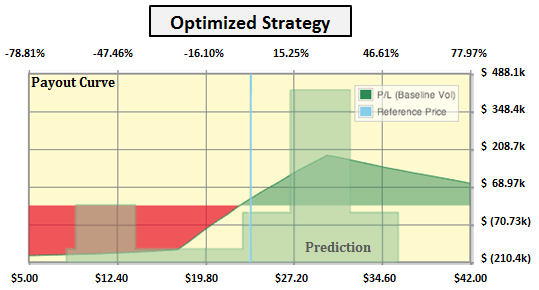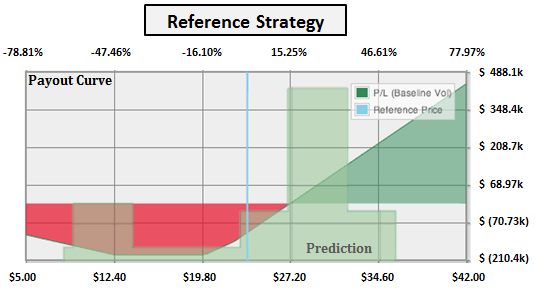RPRX Case Study – October 2013
Summary
This is an event trade on a high-volatility, small-cap stock. The Tradelegs Optimized Strategy increased the expected returns on a fund’s original option strategy almost tenfold, while having the same potential worst-case risk and capital usage. On a marked-to-market basis, the Tradelegs Strategy generated better returns on 29 of the 30 days and ended up profitable, while the Original Strategy incurred a small loss.
Note that the strategy generated using Tradelegs was not executed, but was backtested on the same basis as the original reference strategy.
Background
- RPRX – Repros Therapeutics
- Trade Date: September 9th 2013 / Target Date: October 19th 2013
- Repros Therapeutics [RPRX] is a biotech company focused on endocrine disorders. The company’s lead program has been de-risked by several successful Phase II studies as well as a successful Phase III study. There is one remaining Phase III efficacy study that will be released in October and the outlook is positive
- The Portfolio Manager of an Event-Driven fund put on a trade in an attempt to capture his bullish view on RPRX and protect him against “company-specific trial execution risk”
- We used Tradelegs to identify a better trade with equal or less capital at risk and a lower breakeven point
Assumed PM Prediction and Constraints
Case Study Results
Expected Returns on Entry (Sep 2013)
- The Tradelegs Proposed Strategy is expected to outperform the fund’s Reference Strategy by an average of 970% under normal volatility conditions, and by an average of 200% under adverse volatility
- The Tradelegs Strategy meets all the fund’s trading constraints — even those that their original trade violated
- The Tradelegs Strategy has almost a 15% higher probability of profit inside the predicted range
P&L Payout Curve
Optimized Strategy
- Maximizes profit in the prediction range
- Flattens out in the ranges outside the prediction range so that it could capture more profit inside the prediction range
- Offers increased protection should the stock move against the fund, by delaying cross-over to loss
| |
Reference Strategy
- Requires more than a 15% move to break even
- Peaks outside of the prediction
- Accelerated downside slope bottoms out much sooner than the Optimized Strategy
| |

|
Case Study Conclusions
Actual Backtest Results (Oct 2013)
- The positions were marked-to-market each day until the expiration date of the PM’s Reference Strategy
- On the expiration date, the PM’s Reference Strategy lost $63k while the Tradelegs Strategy made a $40k profit
- The Tradelegs Strategy outperformed the fund’s strategy on 29 out of 30 days
- The Tradelegs Optimized Strategy sustained lower losses on the worst performing days of the trade
- In this small-cap, high volatility case study, Tradelegs generated an Optimized Strategy that outperformed a trade from a successful event fund managing over $8b of assets
- Whether you are an occasional options trader or an experienced options strategist, Tradelegs’ advanced decision-support technology can give you a substantial edge over trading unaided
|




